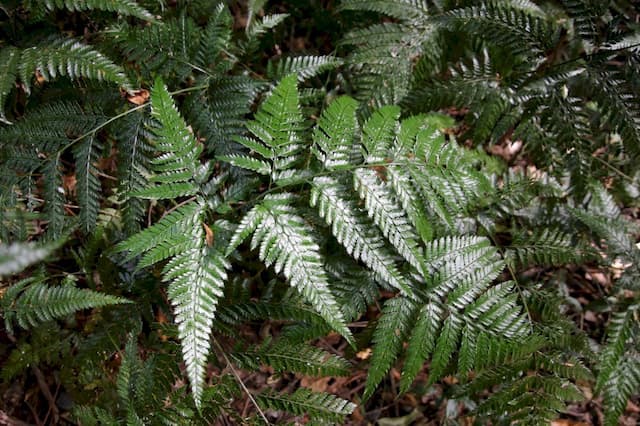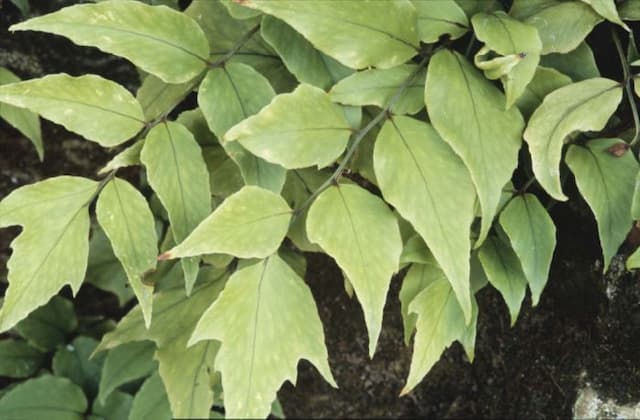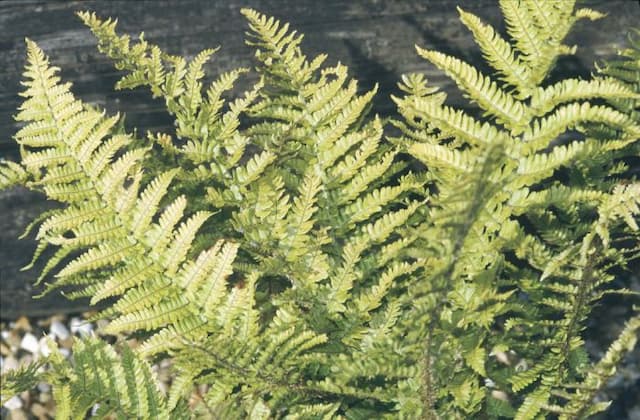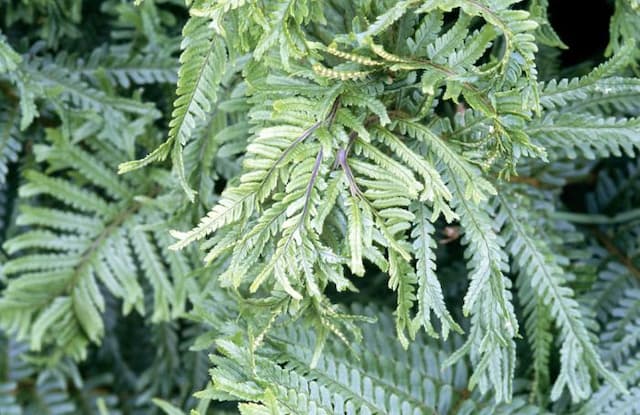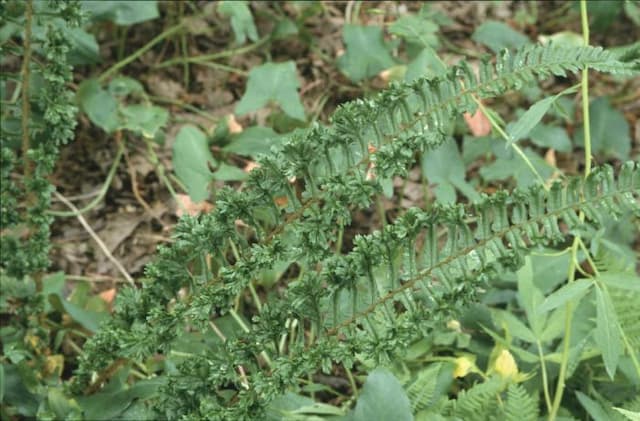Golden Scaled Male Fern Dryopteris affinis 'Crispa Gracilis'

ABOUT
The plant known as the "Crispa Gracilis" is a visually striking form of ferns, notable for its finely subdivided leaves. The leaves themselves exhibit a lush green color that can bring a sense of verdancy and life to any space. The name "Crispa Gracilis" suggests a characteristic appearance, with "crispa" hinting at a crisped or wavy texture, and "gracilis" indicating a slender and graceful form. This fern has a dense, bushy habit, creating a tufted and textured aesthetic with its mass of foliage. This particular type of fern is recognized for its fronds, which are intricately lobed and give the plant a delicate, lacy look. The edges of each individual leaflet are finely ruffled, which amplifies the fern’s overall feathery impression. The leaflets are narrow and the structure of the fronds are held upright, presenting an eye-catching and somewhat architectural feature to the landscape or indoor environment where it is placed. Overall, the "Crispa Gracilis" is an embodiment of intricate detail and natural beauty, making it a favorite among garden enthusiasts and plant collectors who appreciate its distinctive texture and graceful silhouette. Its complex leaf pattern serves as a testament to the intricate beauty that can be found in the plant kingdom.
About this plant
 Names
NamesFamily
Dryopteridaceae
Synonyms
Golden Scaled Male Fern, Curly Male Fern, Narrow Buckler Fern
Common names
Dryopteris filix-mas var. polydactyla, Lastrea gracilis, Nephrodium gracile, Aspidium filix-mas var. polydactylon, Nephrodium polydactylon, Lastrea polydactyla, Dryopteris polydactyla.
 Toxicity
ToxicityTo humans
The plant in question, commonly known as the Golden-scaled Male Fern, is not generally considered toxic to humans. However, like many other ferns, it could potentially cause mild stomach upset if ingested due to the presence of various plant compounds. It’s important to note that the consumption of any non-food plant material may lead to gastrointestinal discomfort or predispose to allergic reactions in sensitive individuals. Therefore, it is advisable to avoid ingesting the Golden-scaled Male Fern or allowing children to chew on its parts.
To pets
For pets such as cats and dogs, the Golden-scaled Male Fern is not specifically listed as a toxic plant. However, the ingestion of non-food plants can sometimes lead to gastrointestinal upset in pets as well, resulting in symptoms such as vomiting, diarrhea, or abdominal pain. It’s often wise to prevent pets from having access to ornamental plants, as individual animals may have unexpected reactions or sensitivities. If your pet has consumed the Golden-scaled Male Fern and is showing any signs of distress, contact your veterinarian.
 Characteristics
CharacteristicsLife cycle
Perennials
Foliage type
Evergreen
Color of leaves
Green
Height
1-2 feet (30-60 cm)
Spread
1-2 feet (30-60 cm)
Plant type
Fern
Hardiness zones
5-9
Native area
Western Europe
Benefits
 General Benefits
General Benefits- Ornamental appeal: The Dryopteris affinis 'Crispa Gracilis', commonly known as the Golden Male Fern, has compact curly fronds that add texture and visual interest to shade gardens or woodland settings.
- Shade tolerance: This fern thrives in shaded areas where other plants may struggle to grow, making it a valuable addition to diverse planting schemes.
- Low maintenance: Once established, it requires minimal care, making it a good choice for gardeners seeking low-maintenance plants.
- Wildlife support: Ferns like the Golden Male Fern provide habitat and shelter for various insects and small wildlife, contributing to ecosystem diversity.
- Erosion control: The fern's root system can help stabilize soil and prevent erosion on slopes or in areas with loose soil.
- Deer resistance: Generally, ferns are not preferred by deer, which can make them a suitable choice for gardens in deer-prone areas.
- Seasonal interest: This perennial plant offers visual interest throughout the growing season with its changing foliage that emerges in spring and matures over summer.
 Medical Properties
Medical PropertiesThis plant is not used for medical purposes.
 Air-purifying Qualities
Air-purifying QualitiesThis plant is not specifically known for air purifying qualities.
 Other Uses
Other Uses- Decoration in Terrariums: Due to its small and dense form, 'Crispa Gracilis' can be used to create a lush, forested look in terrariums or as an underplanting in glass containers.
- Photography Prop: Its unique frilly leaves provide an interesting texture and depth to photographs, particularly in macro photography.
- Dye Production: The plant can potentially be used to produce a natural green dye for fabrics, although not commonly practiced.
- Fairy Gardens: Because of its miniature size and ornate foliage, this type of fern is perfect for creating enchanting fairy garden landscapes.
- Erosion Control: When planted in groups, 'Crispa Gracilis' can help prevent soil erosion due to its dense root system.
- Theme Gardens: This fern can be included in medieval or prehistoric-themed gardens to create an ancient forest ambience.
- Wedding Decor: Its delicate and textured fronds can be used for creating natural wedding bouquets, table centerpieces, or venue decorations.
- Biotope Aquariums: For those creating a European-themed biotope aquarium, this plant can be used around the outside to mirror the native flora.
- Art Subjects: Botanical illustrators or artists may use 'Crispa Gracilis' as a subject due to its intricate leaf patterns.
- Rain Garden Plant: It can be used in rain gardens to utilize its tolerance for damp conditions, contributing to stormwater management.
Interesting Facts
 Feng Shui
Feng ShuiThe plant Dryopteris affinis 'Crispa Gracilis', more commonly known as the Golden-Scaled Male Fern, is not used in Feng Shui practice.
 Zodiac Sign Compitability
Zodiac Sign CompitabilityThe Golden-Scaled Male Fern is not used in astrology practice.
 Plant Symbolism
Plant Symbolism- Resilience: Dryopteris affinis, commonly known as the Golden Scale Male Fern, often thrives in shady, inhospitable environments, making it a symbol of resilience and the ability to grow and persevere in adverse conditions.
- Protection: Ferns in general, including the Golden Scale Male Fern, have long been associated with protection and shelter as they provide cover in the forest undergrowth, symbolizing a haven or protective umbrella for many smaller life forms.
- Secret Bond: In the language of flowers, ferns can represent secret bonds of love or friendship, and by extension, the Golden Scale Male Fern could symbolize a discreet and confidential connection.
- Ancient Wisdom: As ferns are among the oldest groups of plants on earth, they are often associated with ancient wisdom and knowledge, and the Golden Scale Male Fern shares this symbolism, representing the timeless aspects of nature.
 Water
WaterThe Golden Shield Fern should be watered thoroughly, allowing the top inch of soil to dry out between waterings. It is best to water this plant approximately once a week, but this may vary depending on environmental conditions. Use lukewarm water to gently soak the soil until water runs out of the bottom drainage holes, suggesting that the plant has been evenly watered. During the active growing season, it might need more frequent watering, perhaps as much as every 3-4 days, but in the winter, water less often, maintaining just enough moisture to prevent the soil from completely drying out. It is better to err on the side of under-watering than over-watering, as the Golden Shield Fern does not like to sit in waterlogged soil.
 Light
LightThe Golden Shield Fern thrives in partial shade to full shade conditions. Avoid direct sunlight as it can scorch the leaves. The ideal location is a spot where the plant receives indirect but bright light, such as by a north-facing window or a few feet away from an east- or west-facing window. This fern prefers consistent light conditions without prolonged exposure to intense afternoon sun.
 Temperature
TemperatureThe Golden Shield Fern prefers cool to moderate temperature conditions and should ideally be kept between 60 to 70 degrees Fahrenheit. It can tolerate a minimum temperature of around 50 degrees Fahrenheit and maximum of around 75 degrees Fahrenheit. To ensure the best growth, avoid placing your fern near heating vents or air conditioners as drastic temperature changes can stress the plant.
 Pruning
PruningThe Golden Shield Fern benefits from occasional pruning to remove dead or damaged fronds and to maintain a tidy appearance. Pruning is best done in the spring before new growth begins. Cut back any old fronds to the base to make room for new ones. Pruning once a year is generally sufficient for this fern unless there is visible damage or disease which should be addressed immediately.
 Cleaning
CleaningAs needed
 Soil
SoilGolden-scaled male fern thrives best in a well-draining, fertile potting mix composed of one part garden loam, one part leaf mold or compost, and one part coarse sand or perlite. The ideal soil pH for this fern should be mildly acidic to neutral, ranging from pH 6.0 to 7.0.
 Repotting
RepottingGolden-scaled male fern should be repotted every 2 to 3 years to refresh the soil and accommodate root growth. When repotting, select a pot that is only slightly larger than the previous one to maintain appropriate size.
 Humidity & Misting
Humidity & MistingGolden-scaled male fern prefers high humidity levels, ideally between 60% to 70%. If the ambient humidity is lower, especially indoors, consider using a humidity tray or a room humidifier to maintain these conditions.
 Suitable locations
Suitable locationsIndoor
Place in moderate light, ensure high humidity, and maintain cool temperatures.
Outdoor
Plant in dappled shade, protect from extreme heat and wind.
Hardiness zone
5-8 USDA
 Life cycle
Life cycleCommonly known as the Golden-scaled male fern, Dryopteris affinis 'Crispa Gracilis' begins its life cycle as a spore released from the underside of the parent plant's fronds. Upon finding a suitable moist and shady environment, the spores germinate and grow into a heart-shaped gametophyte, which is the sexual stage of the plant. The gametophyte produces both sperm and eggs, and after fertilization, a new sporophyte emerges, which will develop into the familiar fern plant. This juvenile fern, or fiddlehead, unfurls its curled fronds as it matures into an adult fern with a rosette of thick, leathery, and often crinkled fronds. The mature fern is evergreen, persisting through winter, and thrives best in damp, shaded conditions often found in woodland settings. After reaching maturity, the fern reproduces by producing spore-bearing sori on the underside of its fronds, and the life cycle begins anew.
 Propogation
PropogationPropogation time
Spring-Early Summer
The Dryopteris affinis 'Crispa Gracilis', commonly known as the Golden-scaled Male Fern, is usually propagated by division, with the best time to do so being in the spring. This method involves carefully separating mature plants into smaller sections, each with a piece of the rhizome and a growing point or crown. The key is to ensure that each division has at least one frond and a segment of the root system intact. These divisions should then be replanted into moist, well-drained soil, at the same depth they were growing originally, and watered thoroughly. The divisions will establish themselves and grow into independent plants that are genetically identical to the parent plant. This process allows the fern to recover during the growing season, achieving a more successful propagation.
